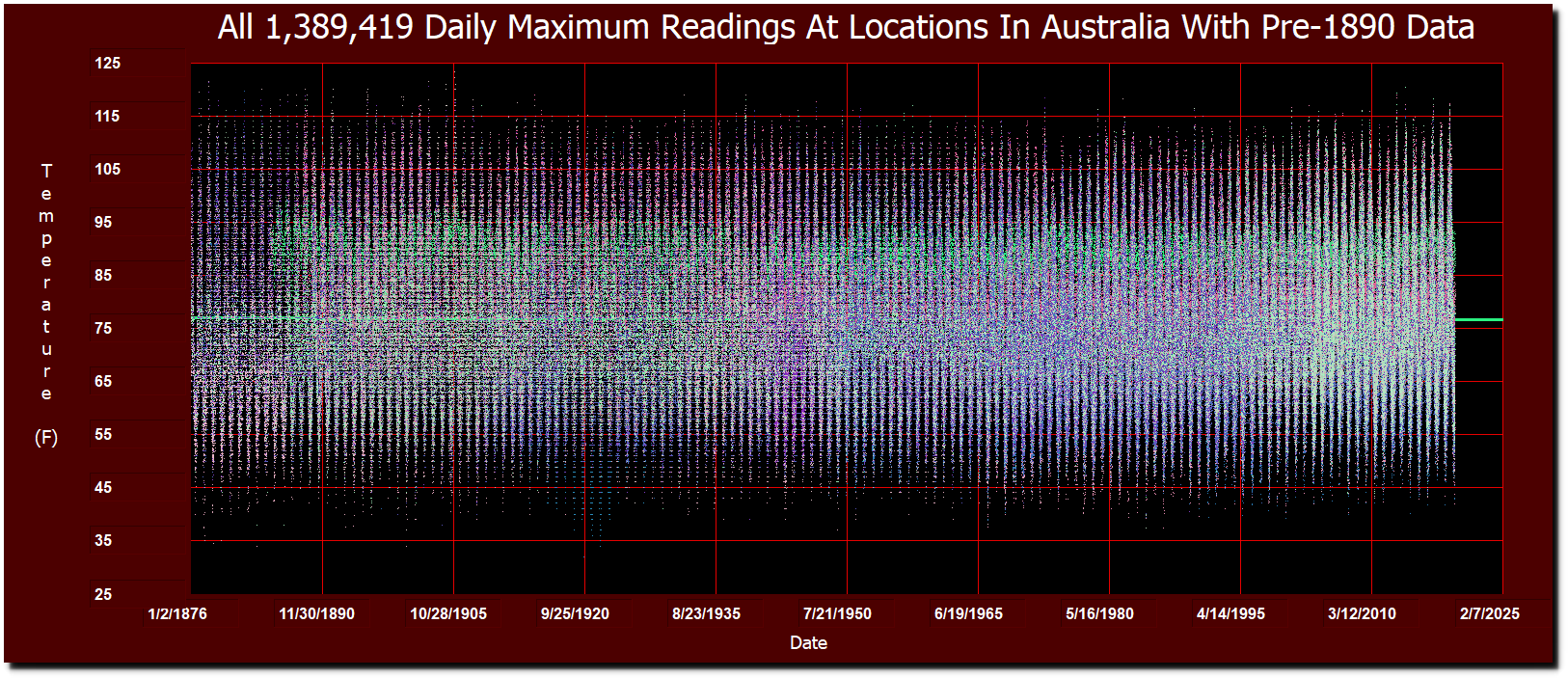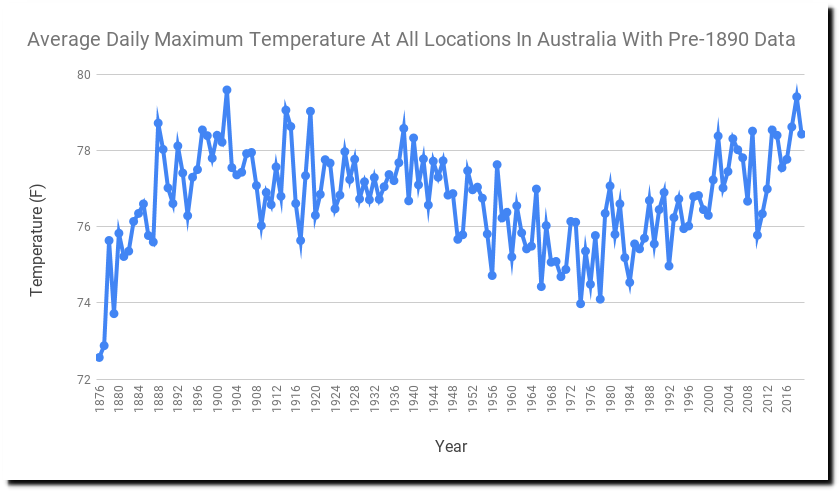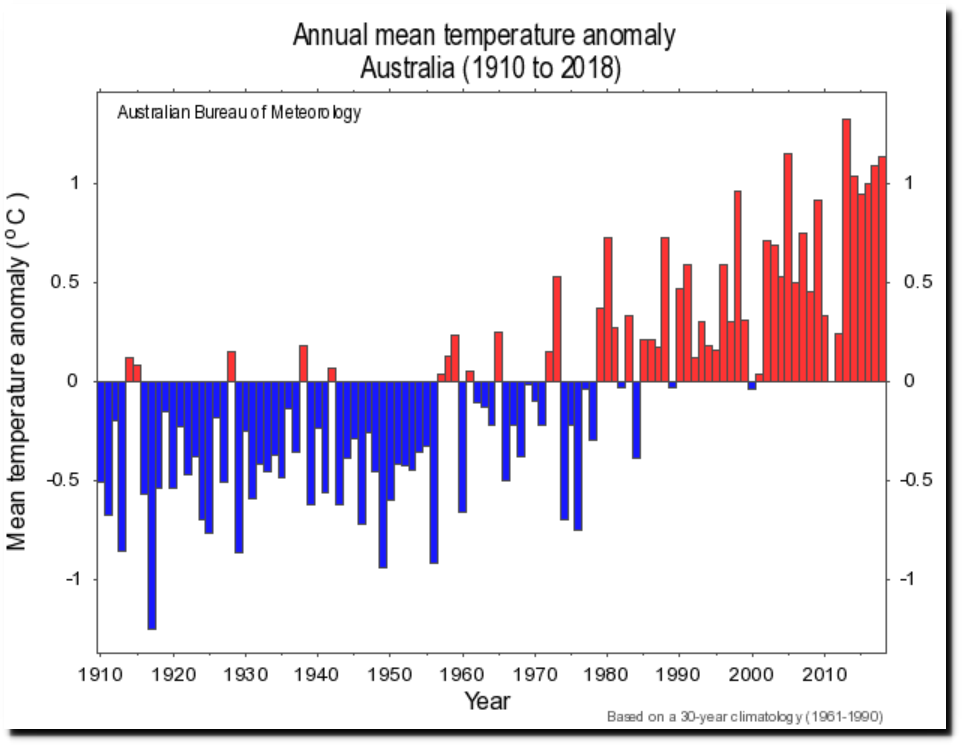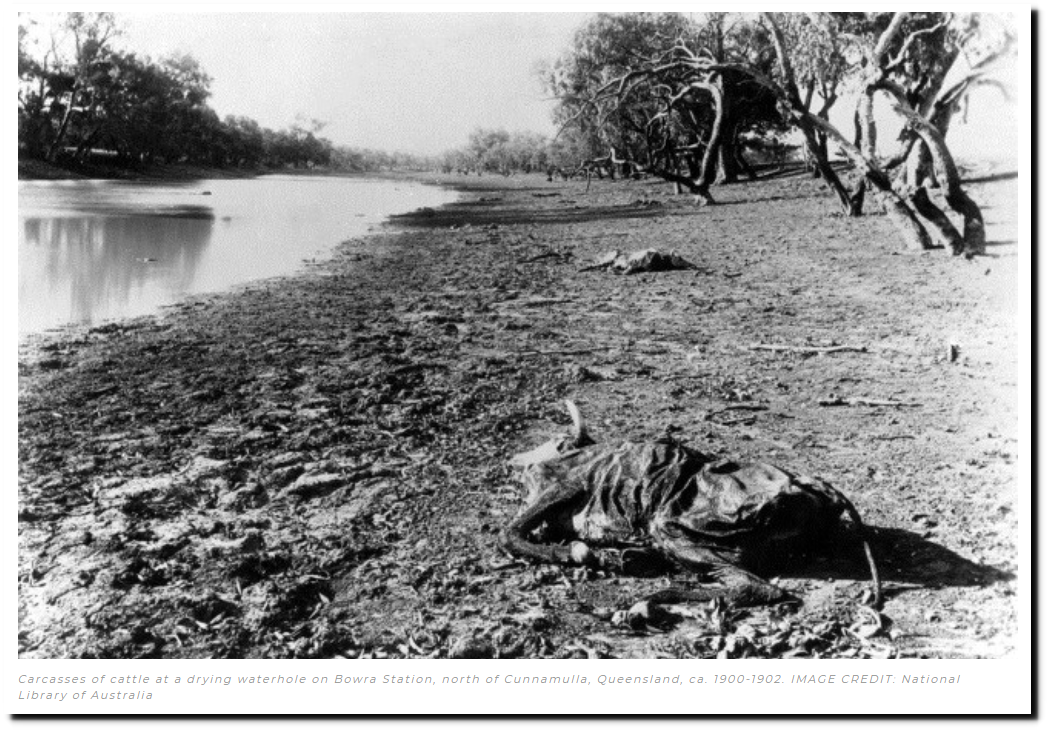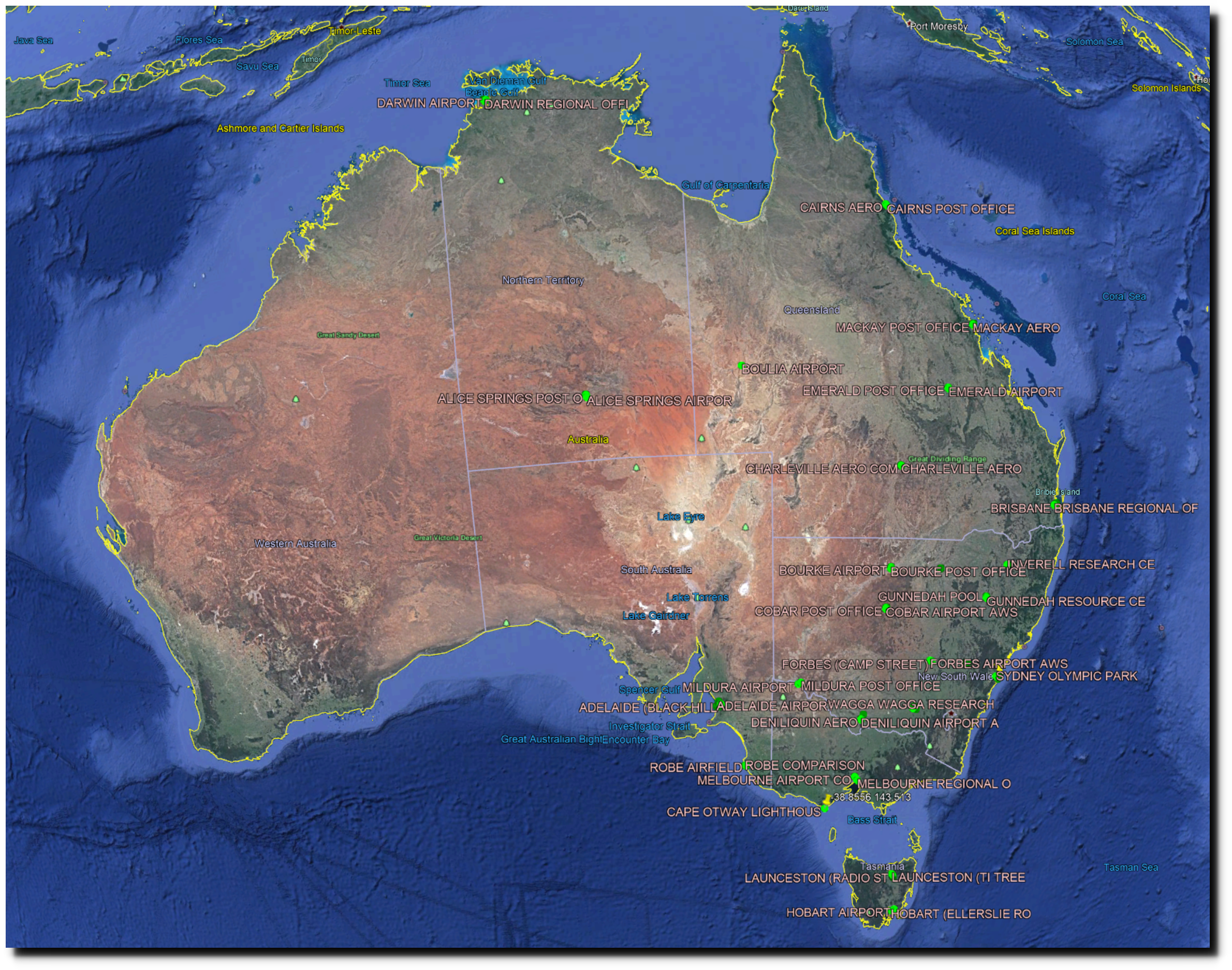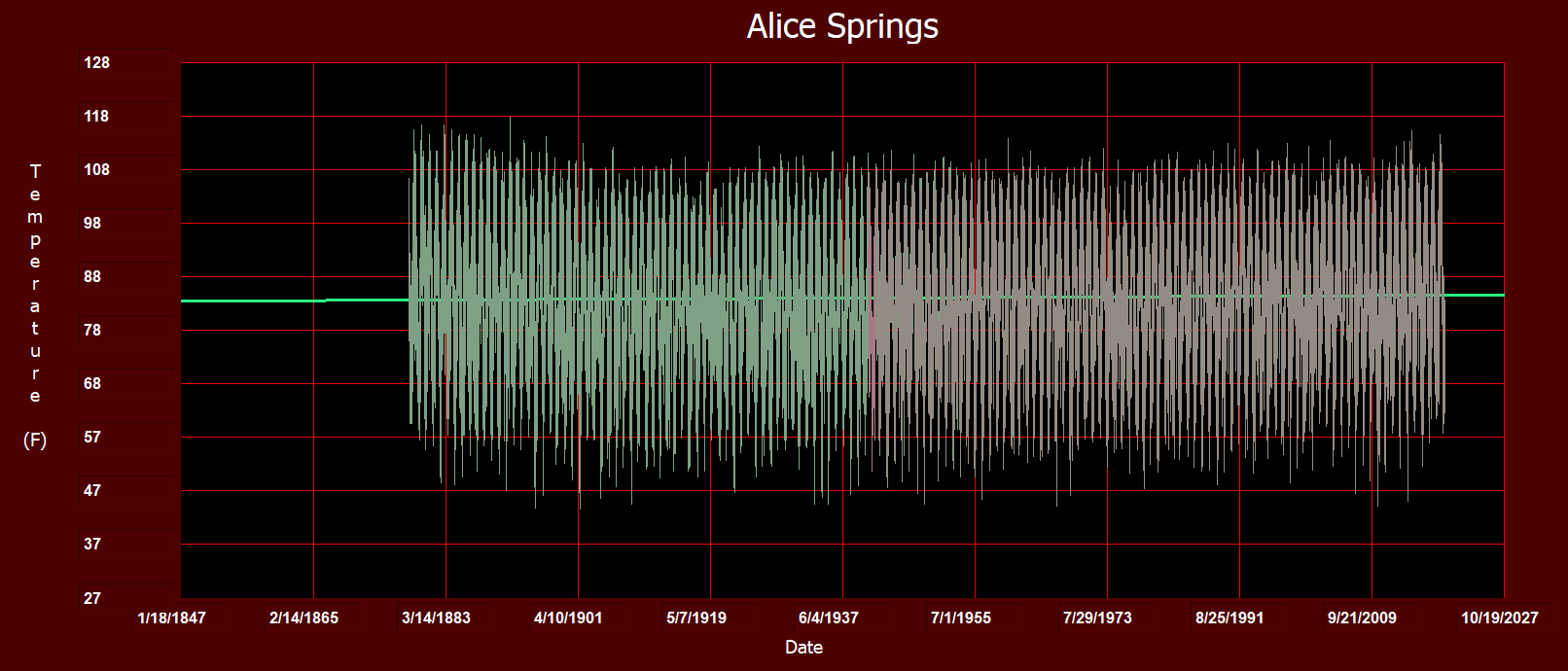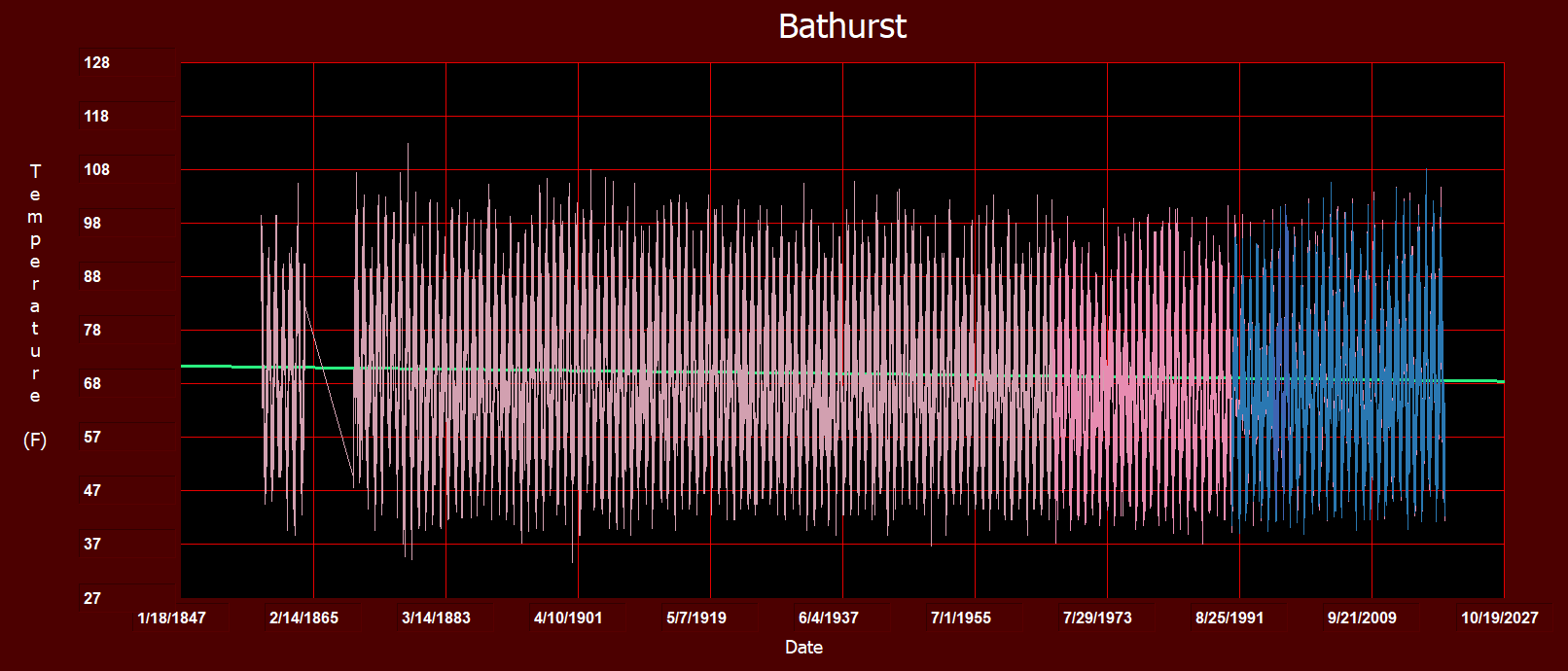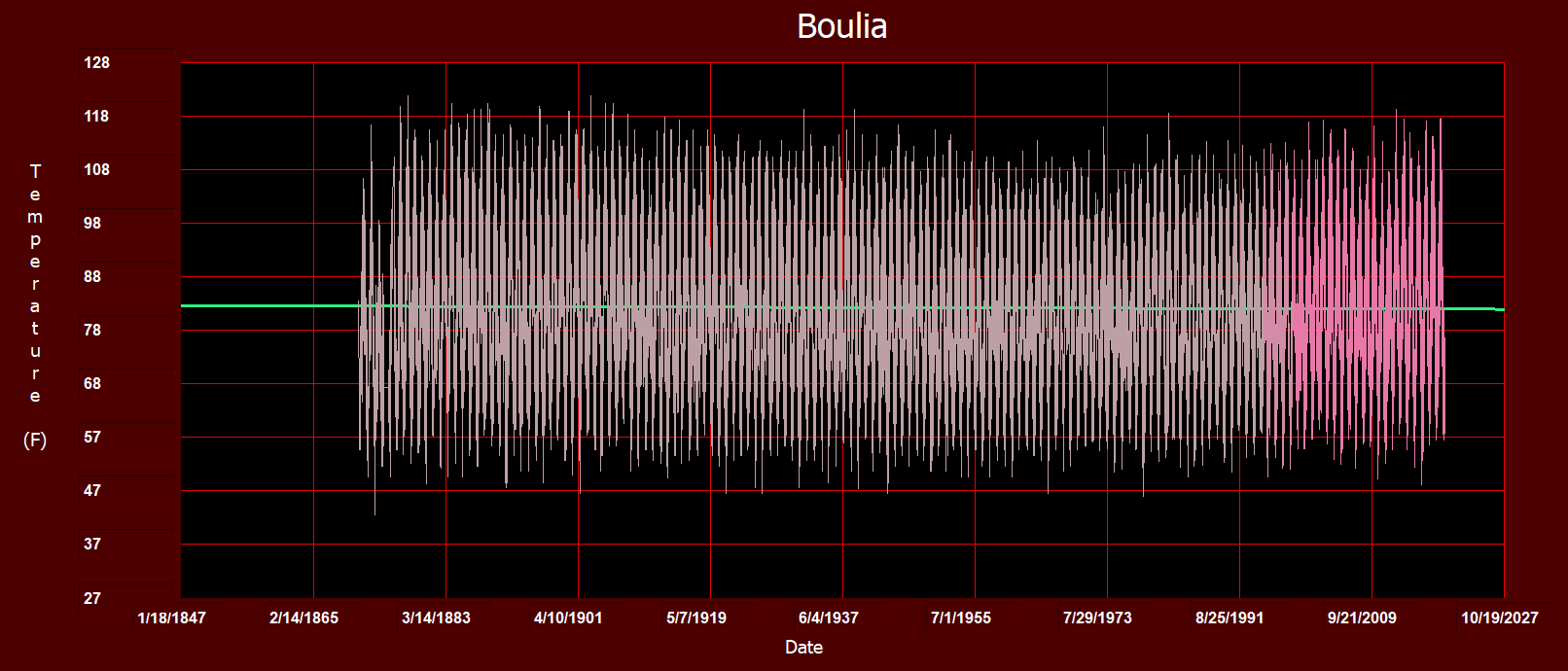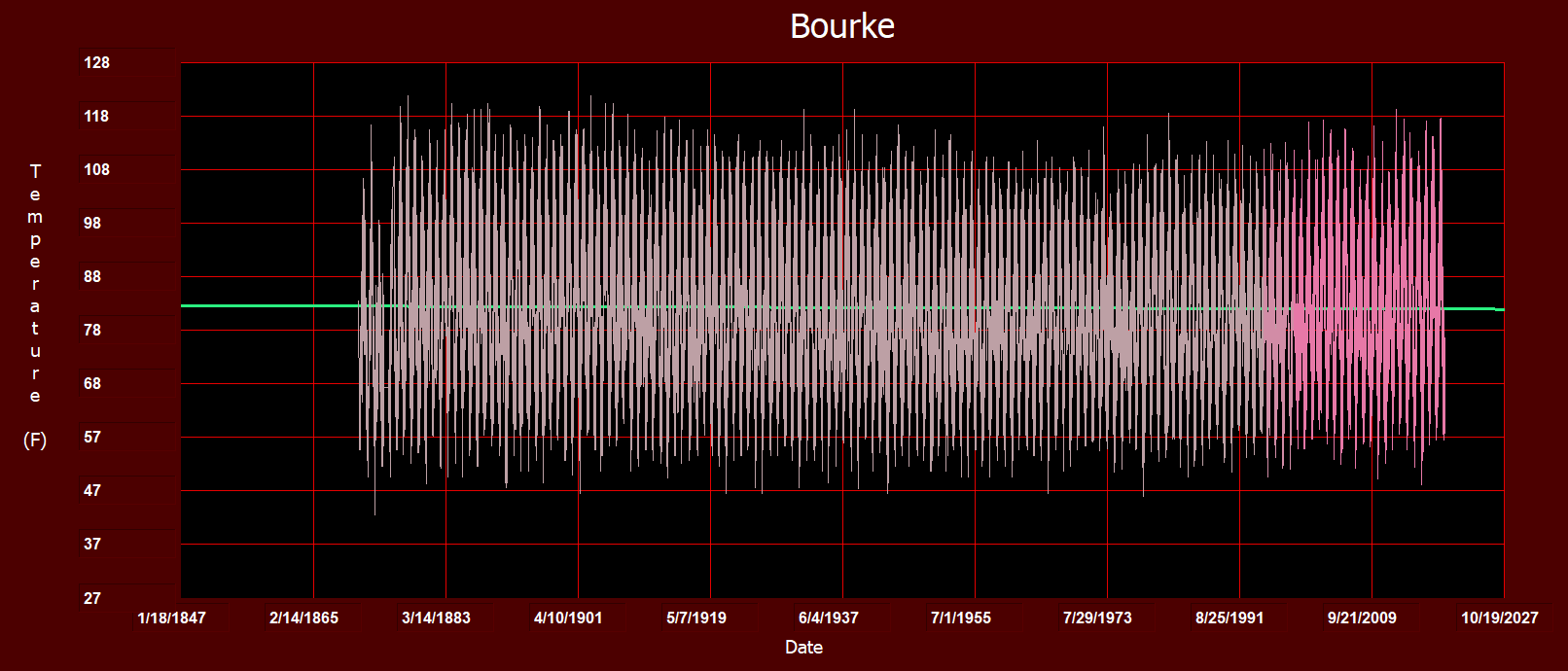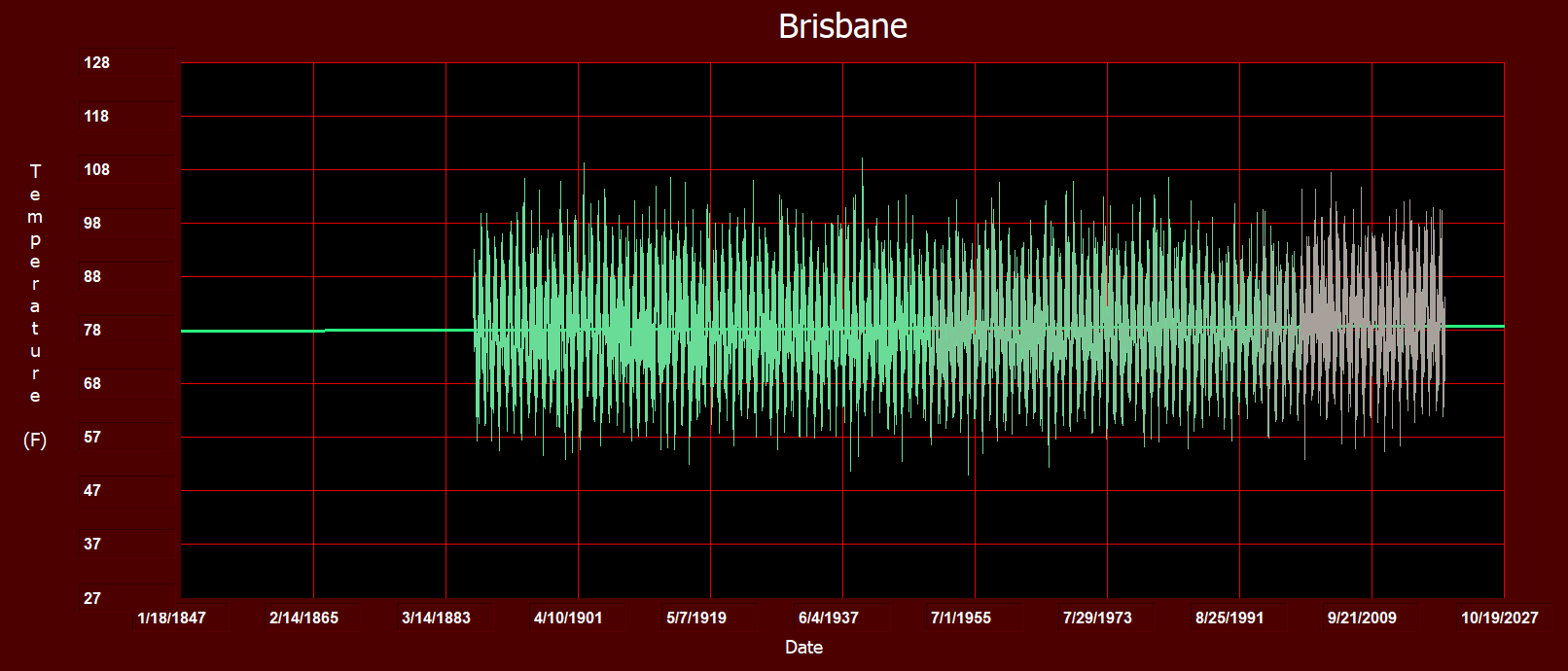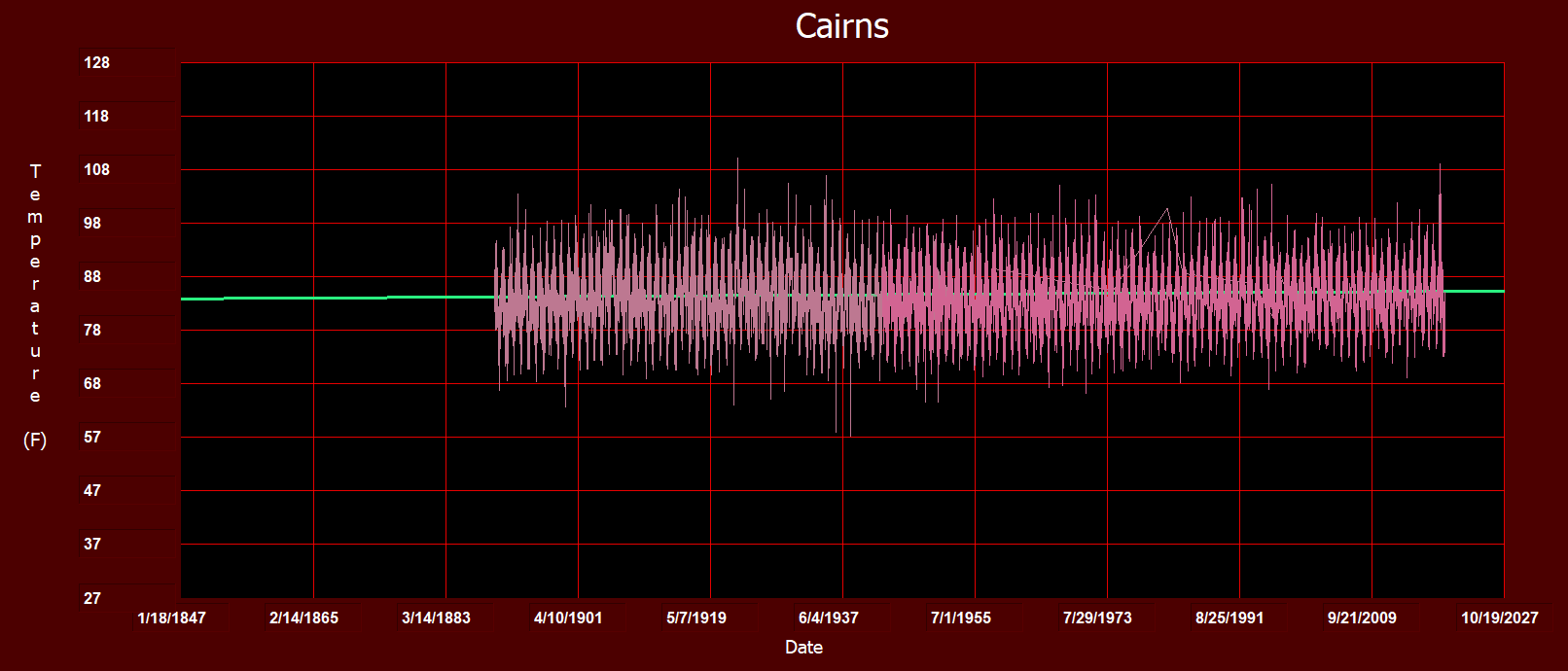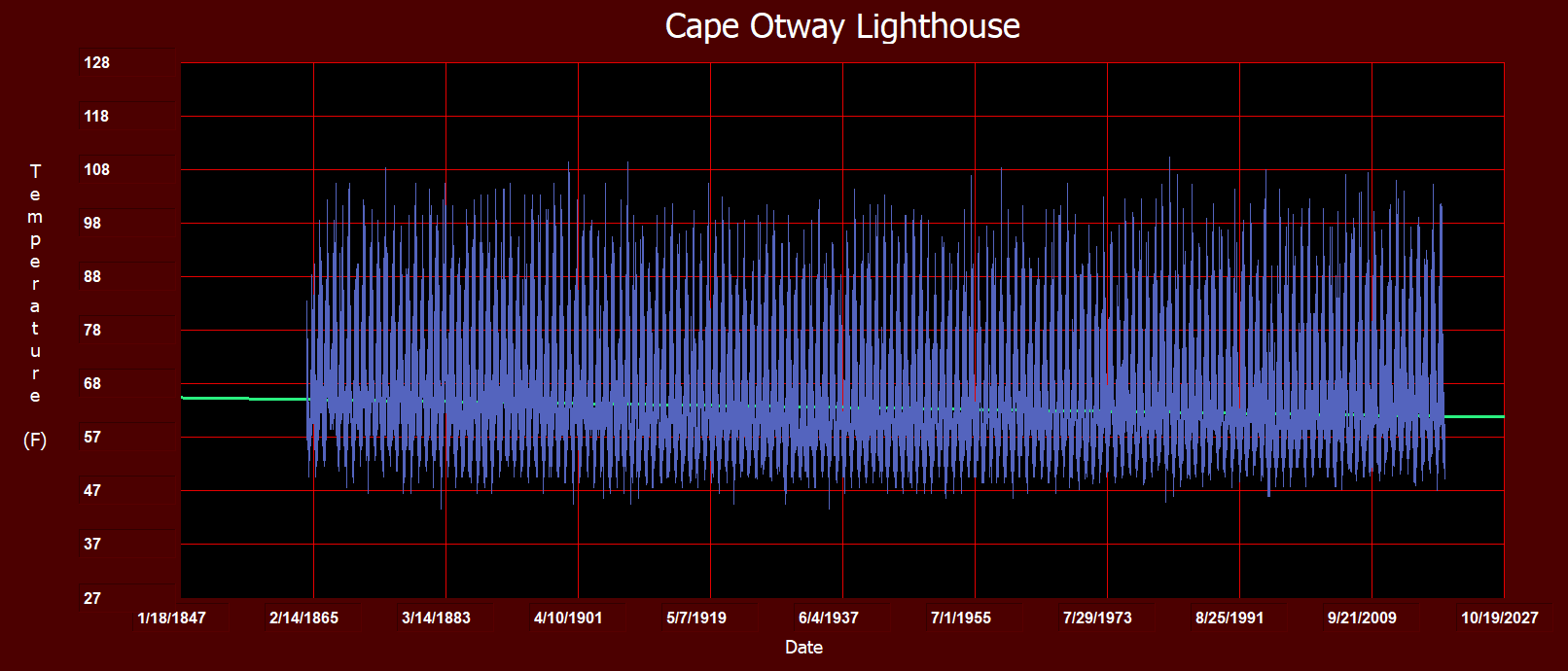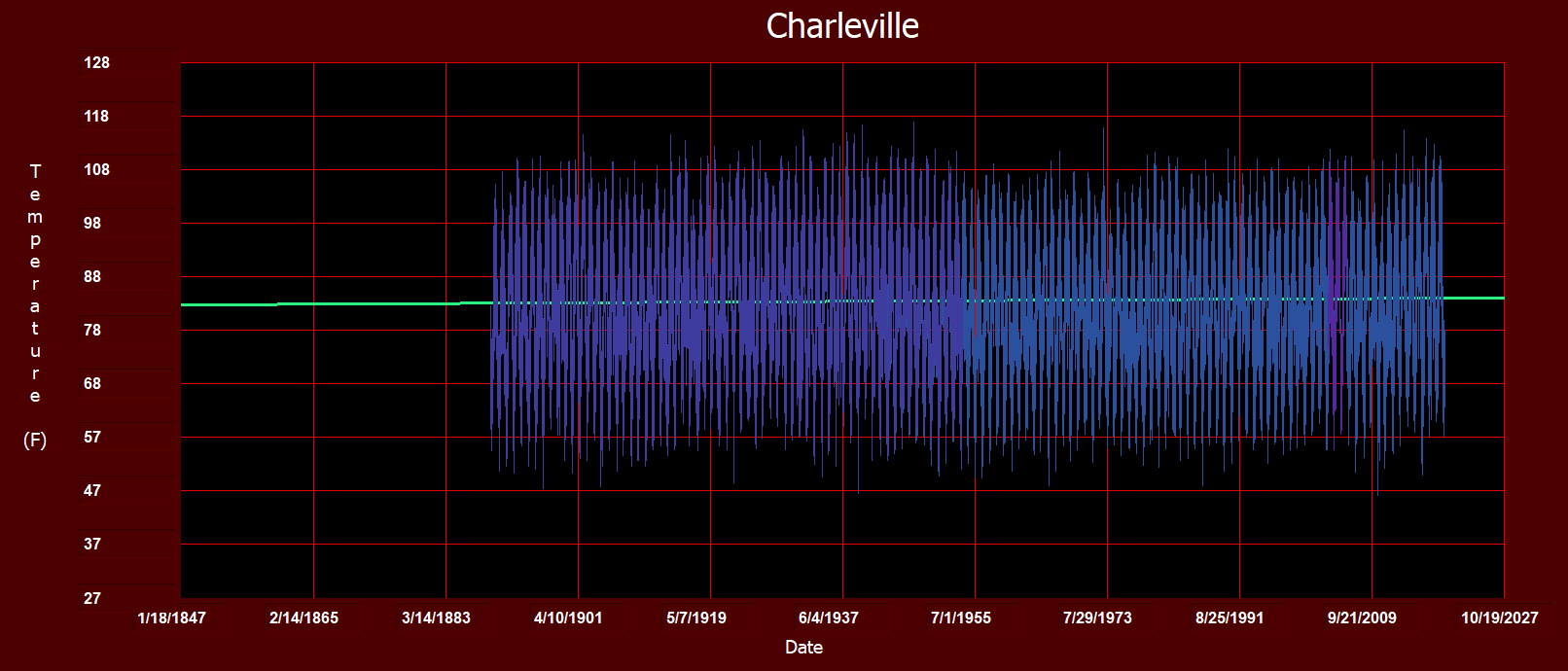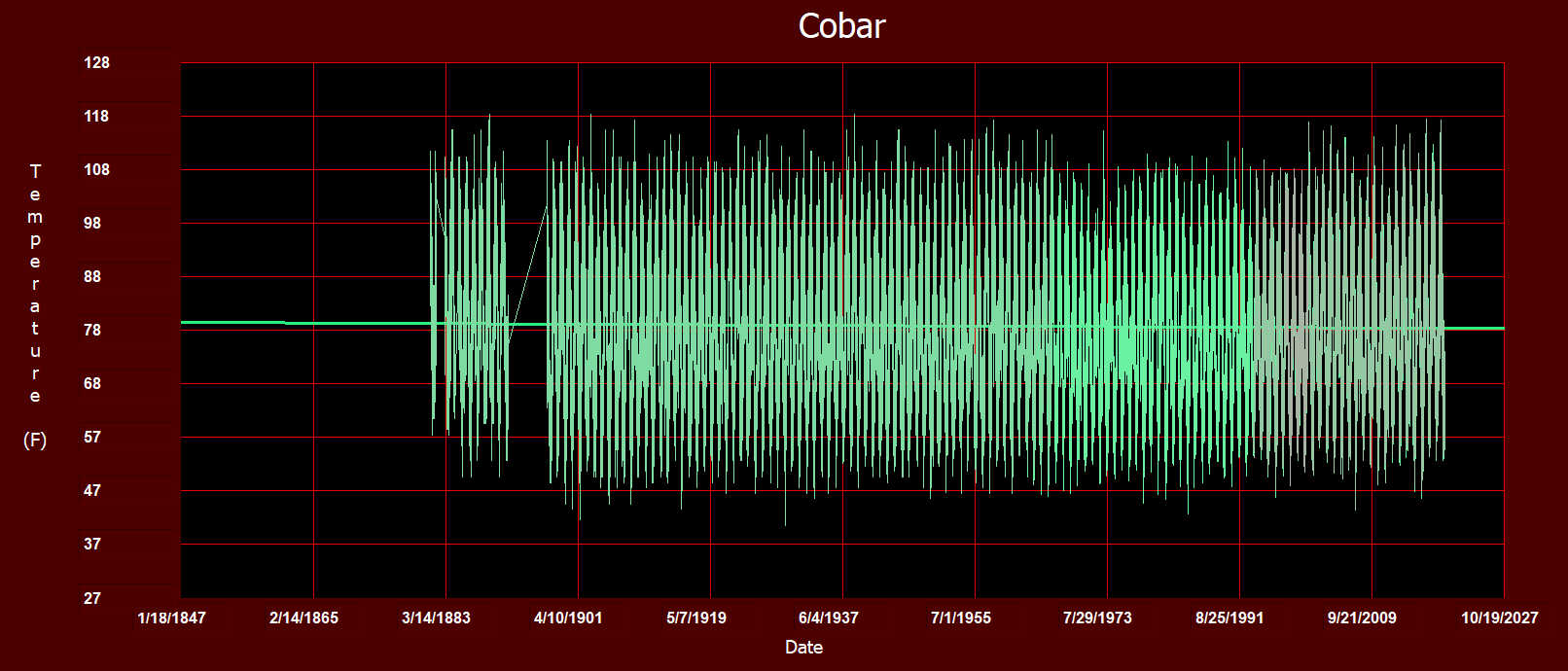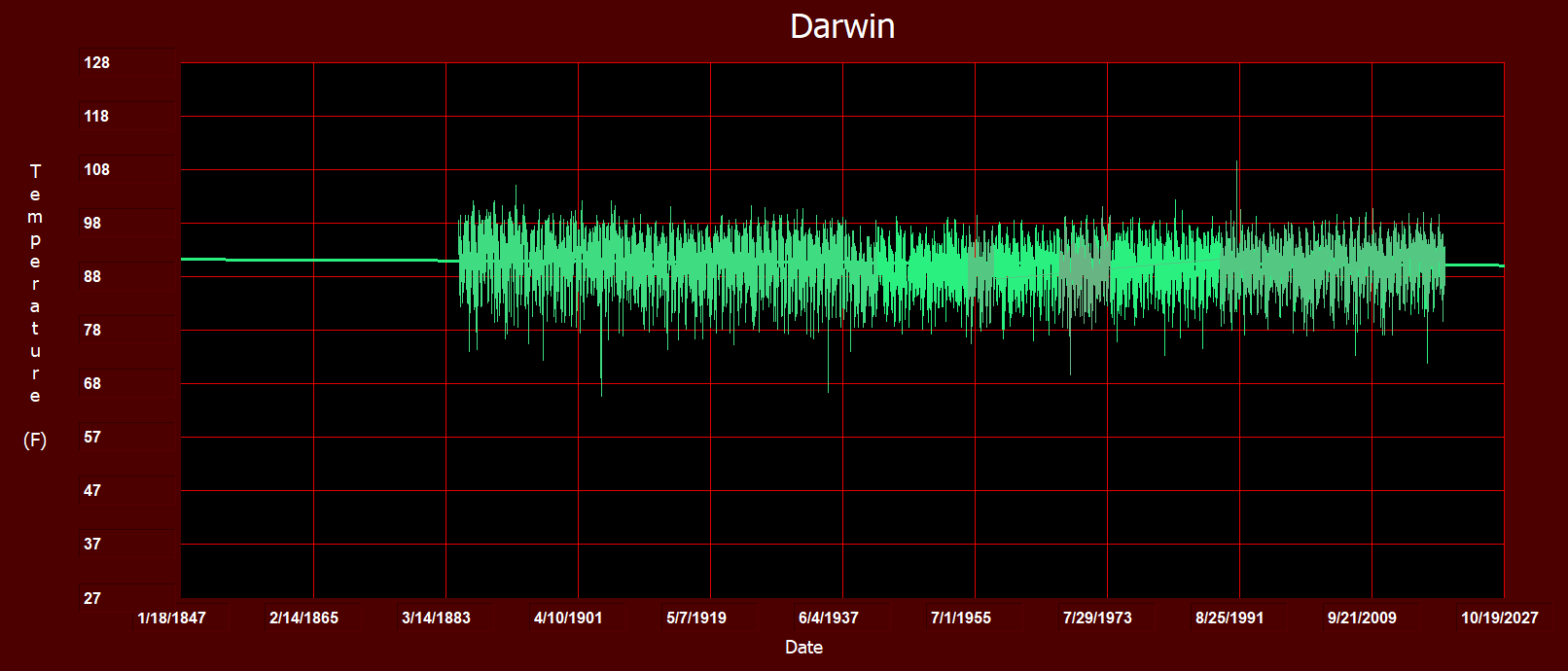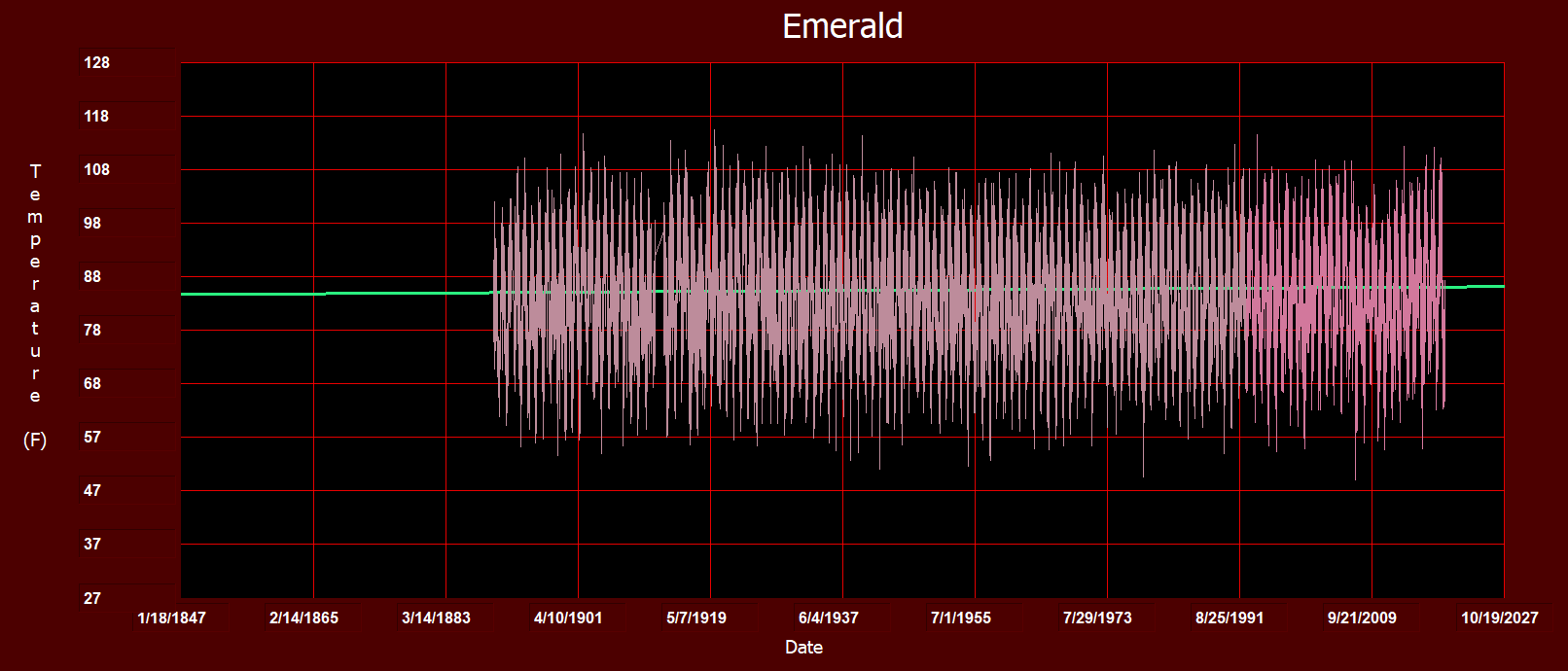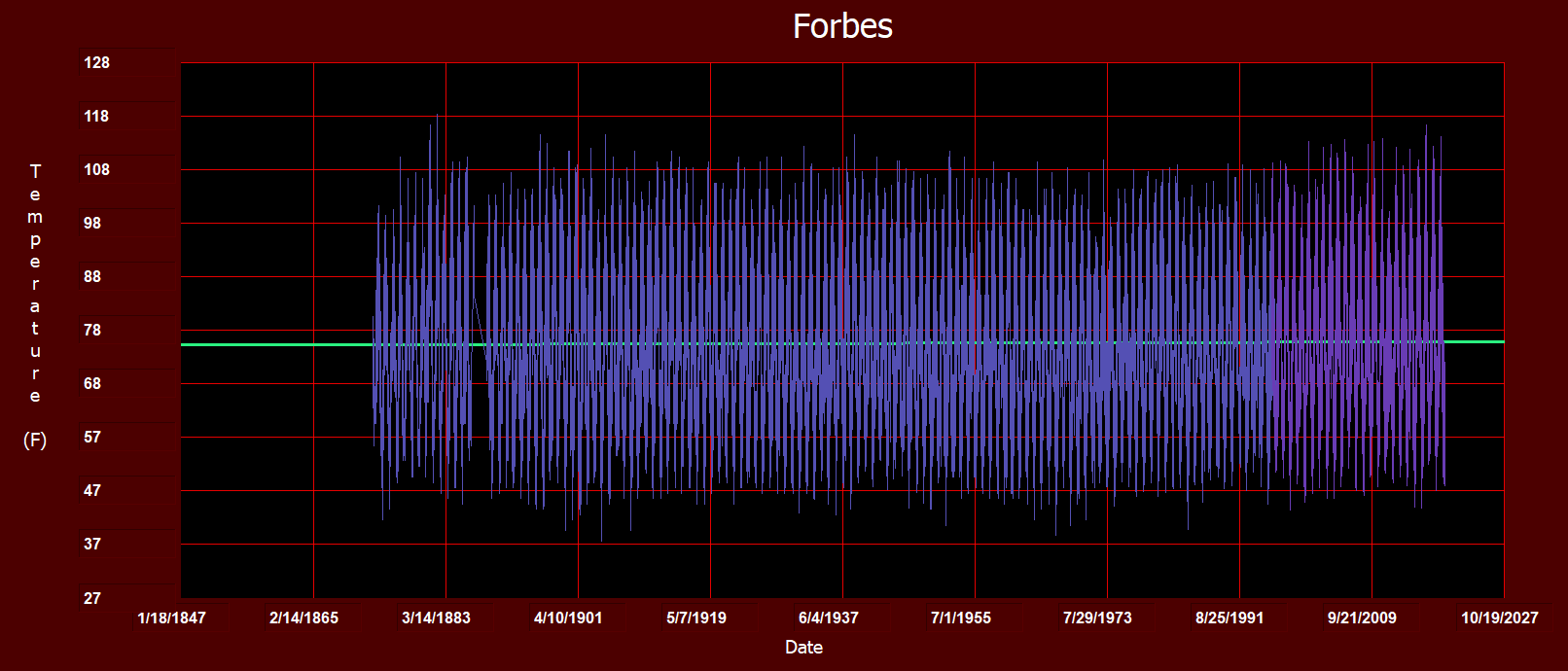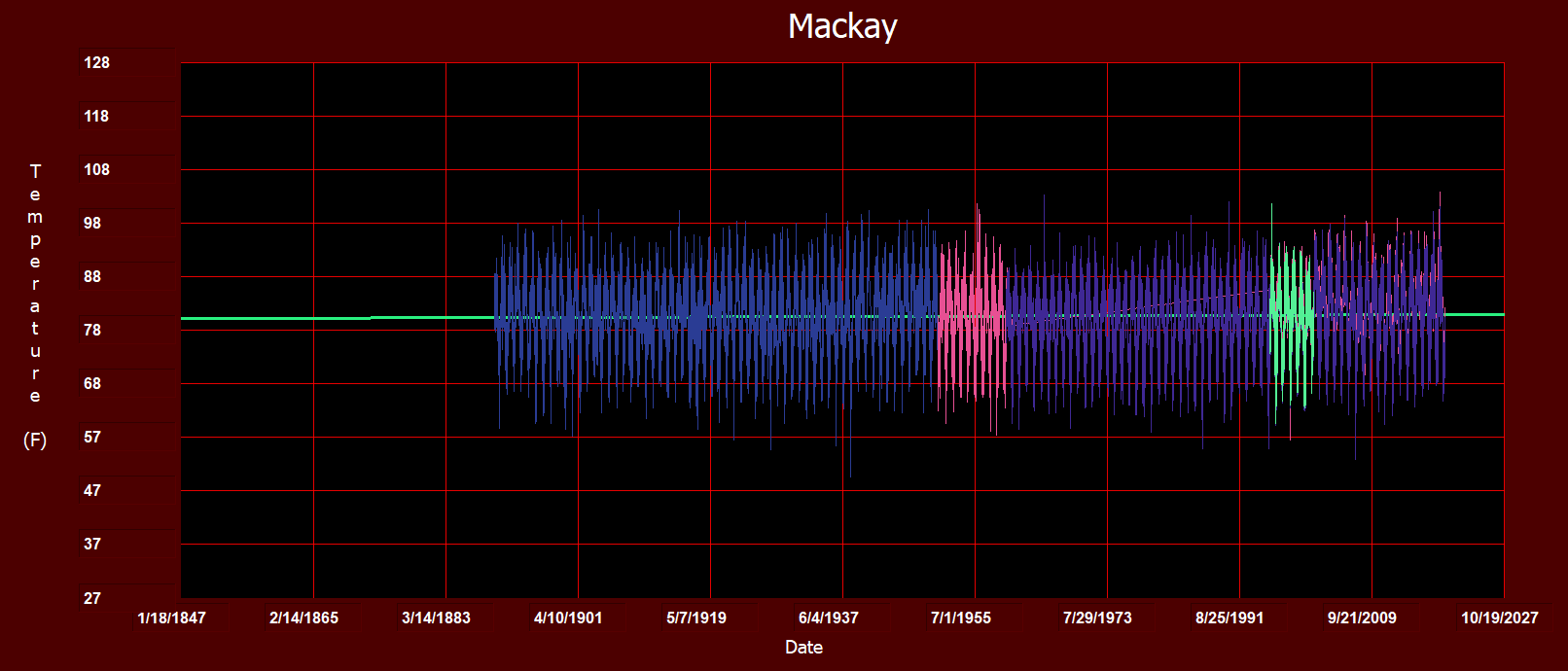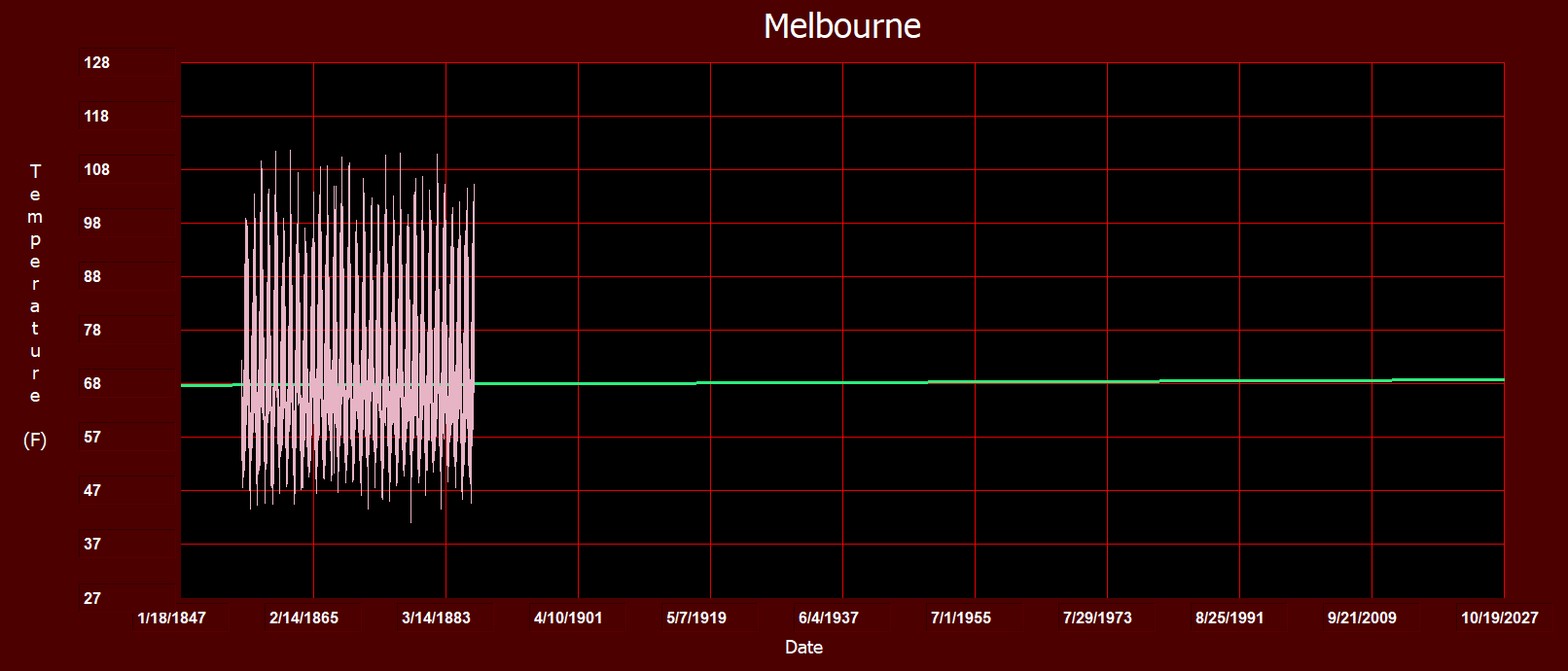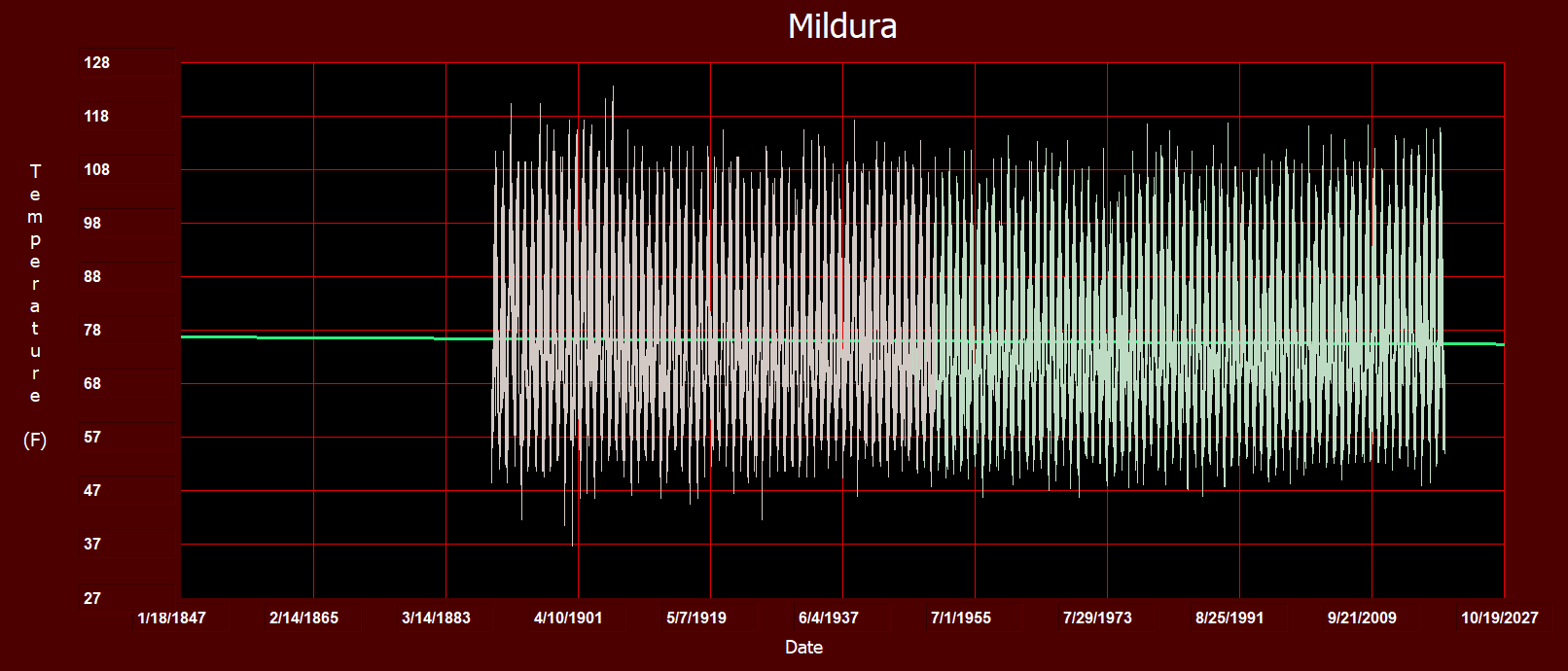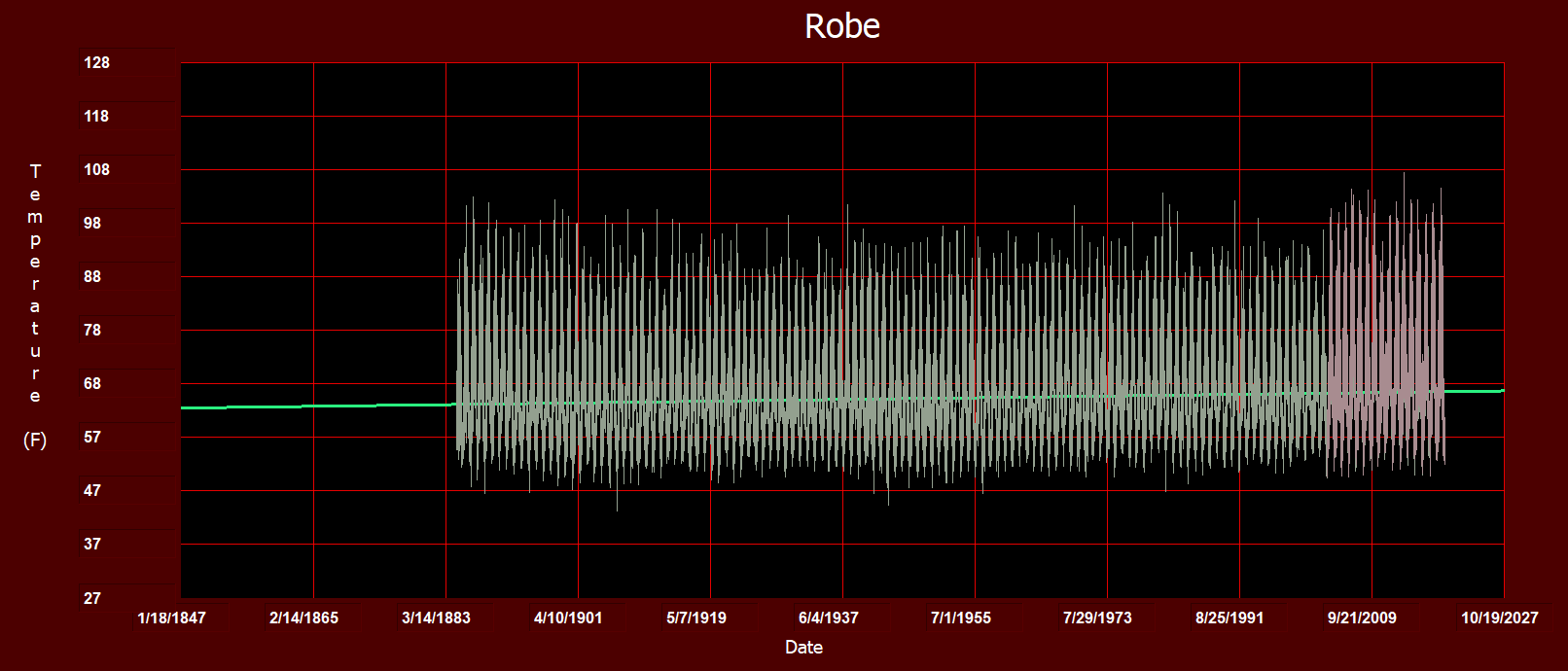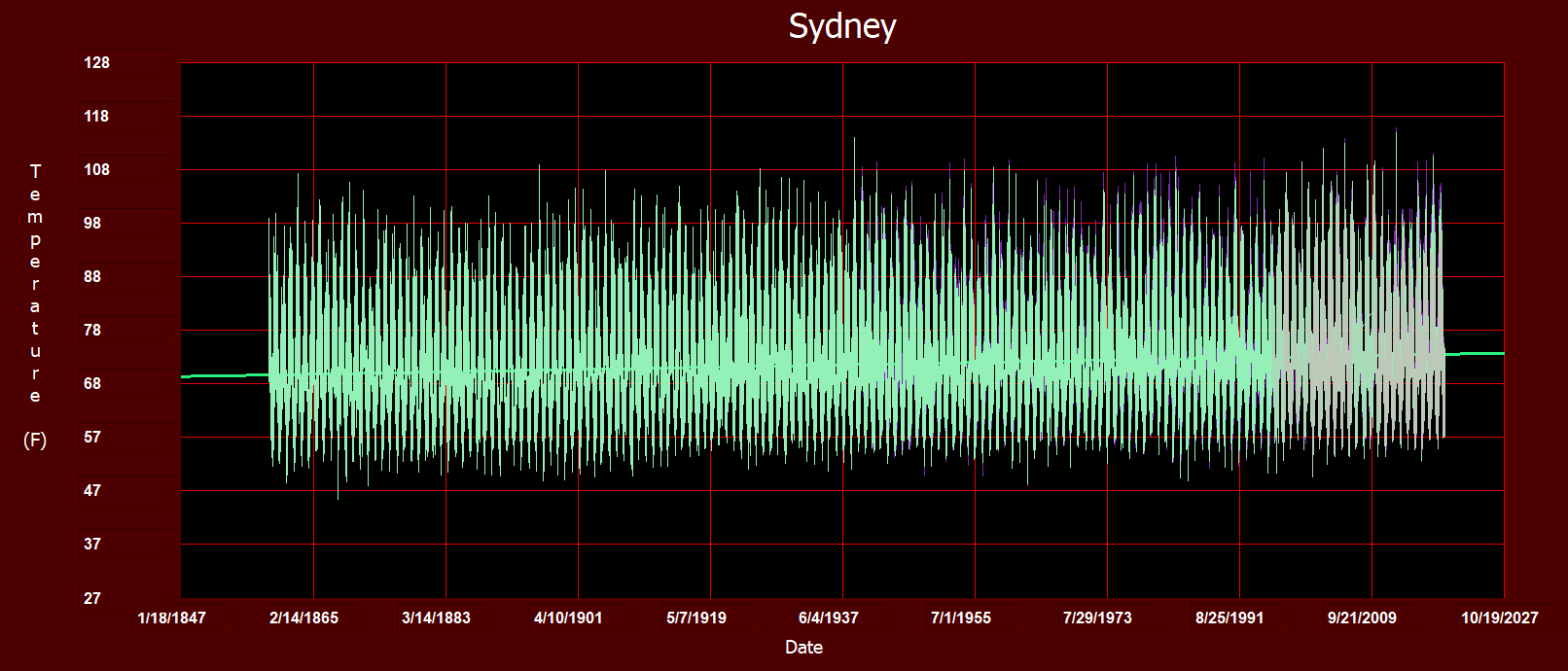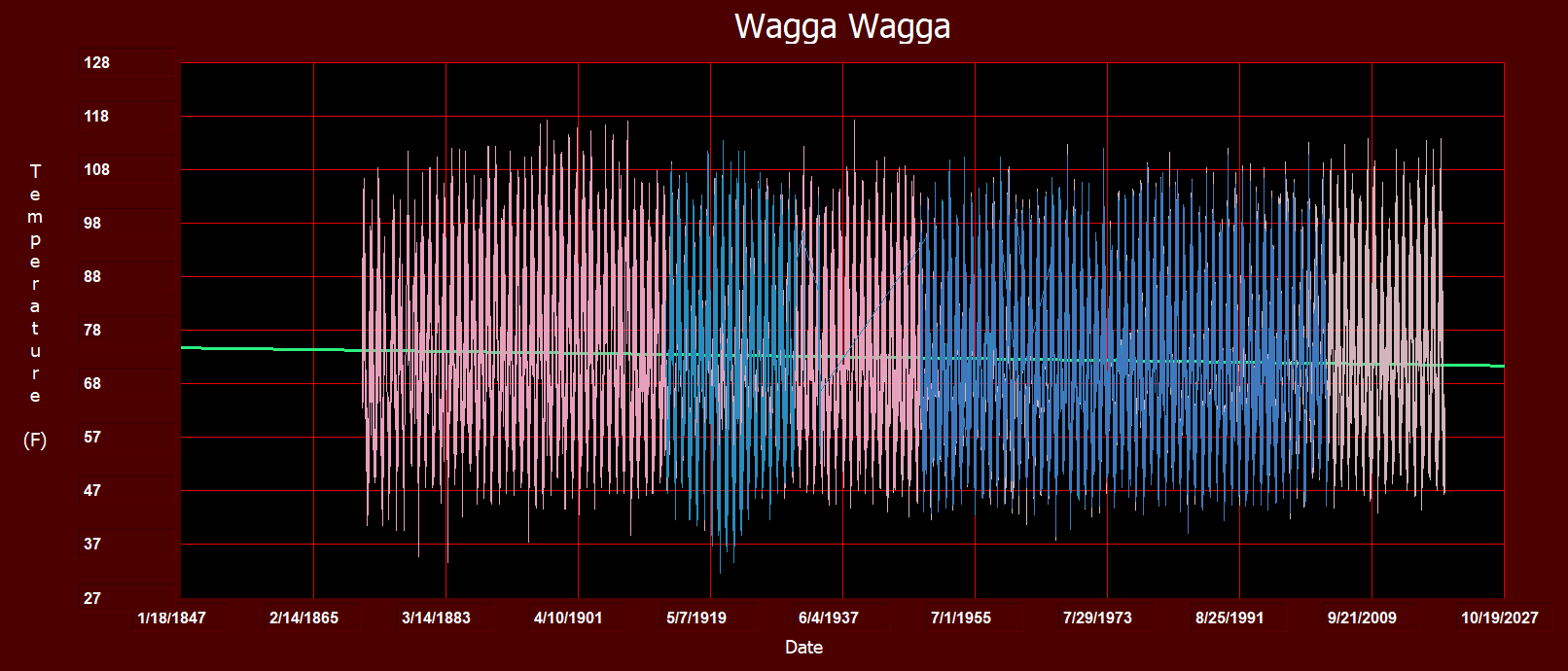There are 25 locations in Australia with daily temperature data going back before 1890. This graph shows all 1,389,419 daily maximum temperature readings at those locations since 1876.
The actual waveform is a 120 year long cycle. The hottest year was 1902 and the second hottest was 2018. Australia was cold during the 1970s ice age scare, just like everywhere else.
The real graph looks nothing like the fake graph generated by BOM, which uses hundreds of fragmented stations with short term records homogenized together into a meaningless hodgepodge of politically useful nonsense.
Climate change and variability: Tracker: Australian timeseries graphs
The hottest year of 1902 was at the end of the worst drought in Australian History – The Federation Drought.
These are all the stations used in the analysis :
ASN00014015.dly : DARWIN AIRPORT -12.4239 130.8925 ASN00014016.dly : DARWIN POST OFFICE -12.4 130.8 ASN00014040.dly : DARWIN AIRPORT COMPARISON -12.4227 130.8844 ASN00014161.dly : DARWIN REGIONAL OFFICE -12.4667 130.8333 ASN00015540.dly : ALICE SPRINGS POST OFFICE -23.71 133.8683 ASN00015590.dly : ALICE SPRINGS AIRPORT -23.7951 133.889 ASN00015634.dly : ALICE SPRINGS CONNELLANS -23.6833 133.85 ASN00023000.dly : ADELAIDE WEST TERRACE -34.9254 138.5869 ASN00023031.dly : ADELAIDE (WAITE INSTITUTE) -34.9697 138.6331 ASN00023034.dly : ADELAIDE AIRPORT -34.9524 138.5204 ASN00023037.dly : ADELAIDE (PARAFIELD PLANT INTR -34.7833 138.6242 ASN00023046.dly : ADELAIDE AIRPORT OLD SITE -34.9566 138.5356 ASN00023057.dly : ADELAIDE (NORTHFIELD RESEARCH -34.8533 138.6517 ASN00023090.dly : ADELAIDE (KENT TOWN) -34.9211 138.6216 ASN00023097.dly : ADELAIDE (BLACK HILL CONSERVAT -34.8833 138.7167 ASN00026026.dly : ROBE COMPARISON -37.1628 139.756 ASN00026105.dly : ROBE AIRFIELD -37.1776 139.8054 ASN00031010.dly : CAIRNS POST OFFICE -16.9333 145.7833 ASN00031011.dly : CAIRNS AERO -16.8736 145.7458 ASN00033045.dly : MACKAY AERO -21.1706 149.1794 ASN00033046.dly : MACKAY POST OFFICE -21.15 149.1833 ASN00033119.dly : MACKAY M.O -21.1172 149.2169 ASN00033297.dly : MACKAY COMPARISON -21.1183 149.215 ASN00040214.dly : BRISBANE REGIONAL OFFICE -27.4778 153.0306 ASN00040223.dly : BRISBANE AERO -27.4178 153.1142 ASN00040842.dly : BRISBANE AERO -27.3917 153.1292 ASN00040913.dly : BRISBANE -27.4808 153.0389 ASN00035027.dly : EMERALD POST OFFICE -23.5267 148.1617 ASN00035264.dly : EMERALD AIRPORT -23.5694 148.1756 ASN00038003.dly : BOULIA AIRPORT -22.9117 139.9039 ASN00044021.dly : CHARLEVILLE AERO -26.4139 146.2558 ASN00044022.dly : CHARLEVILLE POST OFFICE -26.4025 146.2381 ASN00044221.dly : CHARLEVILLE AERO COMPARISON -26.4147 146.2608 ASN00048027.dly : COBAR MO -31.484 145.8294 ASN00048030.dly : COBAR POST OFFICE -31.5 145.8 ASN00048237.dly : COBAR AIRPORT AWS -31.5389 145.7964 ASN00048244.dly : COBAR COMPARISON -31.4861 145.8281 ASN00048013.dly : BOURKE POST OFFICE -30.0917 145.9358 ASN00048239.dly : BOURKE AIRPORT -30.0423 145.952 ASN00048245.dly : BOURKE AIRPORT AWS -30.0362 145.9521 ASN00055023.dly : GUNNEDAH POOL -30.9841 150.254 ASN00055024.dly : GUNNEDAH RESOURCE CENTRE -31.0261 150.2687 ASN00055202.dly : GUNNEDAH AIRPORT AWS -30.9537 150.2494 ASN00052026.dly : WALGETT COUNCIL DEPOT -30.0236 148.1218 ASN00052088.dly : WALGETT AIRPORT AWS -30.0372 148.1223 ASN00056017.dly : INVERELL COMPARISON -29.7783 151.1114 ASN00056018.dly : INVERELL RESEARCH CENTRE -29.7752 151.0819 ASN00056242.dly : INVERELL (RAGLAN ST) -29.7796 151.1121 ASN00063004.dly : BATHURST GAOL -33.4167 149.55 ASN00063005.dly : BATHURST AGRICULTURAL STATION -33.4289 149.5559 ASN00063291.dly : BATHURST AIRPORT AWS -33.412 149.654 ASN00063305.dly : BATHURST AG COMPARISON -33.43 149.555 ASN00065016.dly : FORBES (CAMP STREET) -33.3892 148.0081 ASN00065103.dly : FORBES AIRPORT AWS -33.3627 147.9205 ASN00066037.dly : SYDNEY AIRPORT AMO -33.9465 151.1731 ASN00066062.dly : SYDNEY (OBSERVATORY HILL) -33.8607 151.205 ASN00066195.dly : SYDNEY OLYMPIC PARK (SYDNEY OL -33.8521 151.0646 ASN00066196.dly : SYDNEY HARBOUR (WEDDING CAKE W -33.8414 151.2633 ASN00072150.dly : WAGGA WAGGA AMO -35.1583 147.4573 ASN00072151.dly : WAGGA WAGGA (KOORINGAL) -35.1333 147.3667 ASN00073127.dly : WAGGA WAGGA AGRICULTURAL INSTI -35.0517 147.3493 ASN00074114.dly : WAGGA WAGGA RESEARCH CENTRE -35.1311 147.3091 ASN00090015.dly : CAPE OTWAY LIGHTHOUSE -38.8556 143.5128 ASN00074039.dly : DENILIQUIN FALKINER MEMORIAL -35.3667 145.05 ASN00074128.dly : DENILIQUIN (WILKINSON ST) -35.5269 144.952 ASN00074210.dly : DENILIQUIN AERO -35.5333 144.9667 ASN00074258.dly : DENILIQUIN AIRPORT AWS -35.5575 144.9458 ASN00076031.dly : MILDURA AIRPORT -34.2358 142.0867 ASN00076077.dly : MILDURA POST OFFICE -34.1833 142.2 ASN00086071.dly : MELBOURNE REGIONAL OFFICE -37.8075 144.97 ASN00086282.dly : MELBOURNE AIRPORT -37.6655 144.8321 ASN00086384.dly : MELBOURNE AIRPORT COMPARISON -37.675 144.8419 ASN00091049.dly : LAUNCESTON (PUMPING STATION) -41.5 147.2 ASN00091104.dly : LAUNCESTON AIRPORT COMPARISON -41.5397 147.2033 ASN00091123.dly : LAUNCESTON (MOUNT PLEASANT) -41.4667 147.15 ASN00091179.dly : LAUNCESTON (RADIO STATION 7EX) -41.45 147.15 ASN00091218.dly : LAUNCESTON (ELPHIN) -41.45 147.1667 ASN00091237.dly : LAUNCESTON (TI TREE BEND) -41.4194 147.1222 ASN00091311.dly : LAUNCESTON AIRPORT -41.5492 147.2144 ASN00094008.dly : HOBART AIRPORT -42.8339 147.5033 ASN00094029.dly : HOBART (ELLERSLIE ROAD) -42.8897 147.3278
All of the locations with trend lines are shown below. Changes of color indicate a station change at the same city or town.
Something is wrong with the current Melbourne NOAA data.

